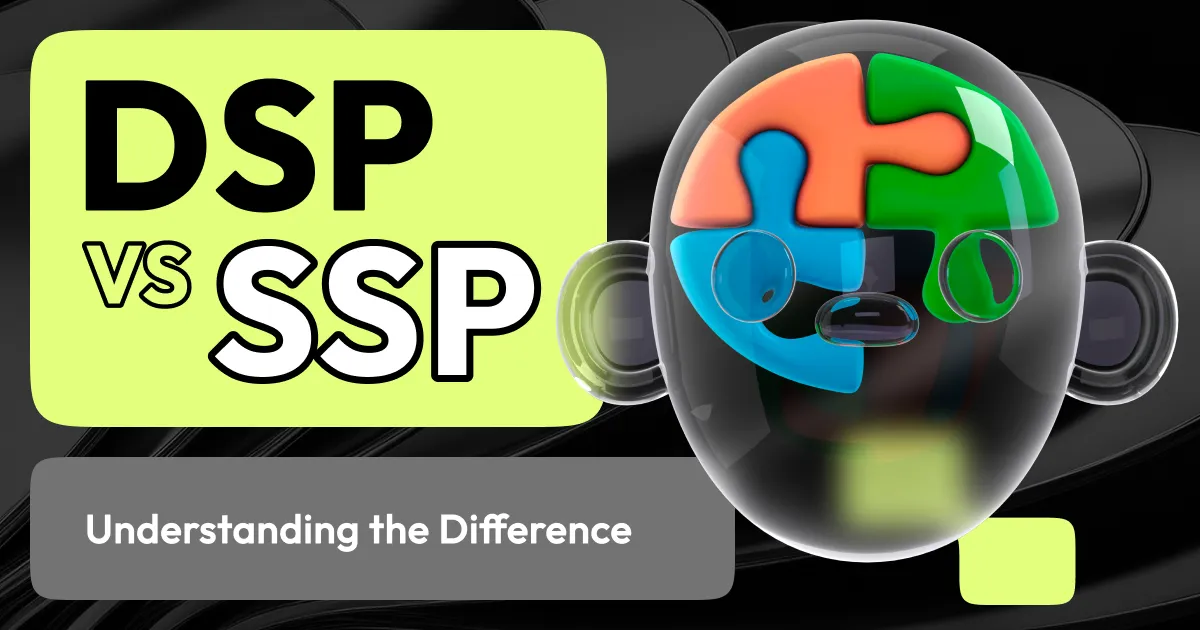Digital advertising involves a great range of tools and platforms that help advertisers achieve greater efficiency. Some of the most important tools in this domain are Demand-Side Platforms (DSPs) and Supply-Side Platforms (SSPs). What are the main differences between such tools and how can they drive programmatic advertising? In this article, we will explore the difference between DSP and SSP. We will also define their unique functions and uncover valuable insights into the role of DSPs and SSPs in digital advertising, along with their benefits fitting different use cases.
What is a demand-side platform (DSP)?
A Demand-Side Platform (DSP) is a software platform that allows advertisers to automate their purchase of digital ad inventory across different channels. Such a solution covers ad purchasing across websites, mobile apps, and videos. With a DSP, advertisers use real-time bidding to target specific audiences based on data-driven insights.
The most common and important features of a Demand-Side Platform include:
Real-time bidding
Advanced configurations for audience targeting
Omnichannel advertising
Tools for managing and optimizing ad campaigns
Dynamic creative optimization features
Analytics and reporting
Fraud detection mechanics
Inventory access
Functionality for managing and tracking campaign costs
Integration with other solutions within an adtech ecosystem.
What is a supply-side platform (SSP)?
A Supply-Side Platform (SSP) is a platform that helps ad publishers manage, sell, and optimize their digital advertising inventories. SSPs connect to DSPs and multiple ad networks to enable real-time bidding for ad impressions. With an SSP advertising technology, publishers can automate the selling process and enhance their revenue by selling their digital ads across different channels.
The core features of a Supply-Side Platform are:
Functionality for inventory management
Real-time bidding (RTB) integration
Yield optimization tools
Advanced configuration for audience targeting and segmentation
Functionality for analytics and reporting
Fraud detection tools
Integration with DSPs and ad exchange platforms
Functionality for managing ad prices
How can advertisers benefit from using a DSP?
Cost-effective ad space purchasing
Automation for the process of negotiating and purchasing digital ads
Access to a diverse network of publishers
Advanced audience targeting and segmentation features
Comprehensive analytics and reporting tools
Scalability for running campaigns across multiple channels.
How can publishers benefit from using an SSP?
Functionality that allows publishers to automate ad inventory management and selling
Access to a wide range of DSP advertising tools, ad networks, and exchanges
Real-time bidding and diverse features for connecting to advertisers, which allows publishers to increase their revenue
Content control, for enhanced management of advertising campaigns
Frequency capping to limit ad repetition and reduce viewer ad fatigue
More precise ad targeting and audience segmentation.
Demand-side platform vs. supply-side platform: comparative table
Now that you know about the main benefits of Demand-Side and Supply-Side Platforms, let's outline the core differences between such solutions. Here is a table comparing DSP vs. SSP advertising platforms.
Aspect | DSP | SSP |
Purpose | Allowing advertisers to buy inventory across multiple channels | Aid publishers in selling ad inventory to advertisers |
Users | Advertisers and various agencies involved in advertising | Publishers and media owners |
Focus | Increasing ROI and efficiency of advertising campaigns for advertisers | Maximizing revenue for publishers, enabling them to find new channels for selling ad inventory |
Function | Automates ad purchase and bidding | Helps publishers reach advertisers and sell their ad inventory to them |
How DSPs and SSPs work together
Even though this article focuses on the supply side vs. demand side platform comparison, it is important to mention that such technologies may work well together. Demand-Side Platforms (DSPs) and Supply-Side Platforms (SSPs) are a perfect pair for programmatic advertising. Together, they create a seamless flow of digital advertising, bringing benefits to both advertisers and publishers. Therefore, DSPs and SSPs work in a symbiotic manner. A DSP in digital marketing serves the demand side because it is used by advertisers willing to buy ad impressions at the most competitive prices. Meanwhile, SSPs are relevant to the supply side because they empower publishers to sell their ad inventory at the highest possible value. In such conditions, DSPs and SSPs enable an efficient and automated exchange of ad inventory in real time.
DSPs and SSPs primarily interact through ad exchanges. When a user visits a web page, an SSP sends a notification about the available ad impression to an ad exchange platform. After that, the ad exchange platform reaches out to multiple DSPs, each representing a different advertiser. The DSP then analyzes the impression data, such as audience characteristics and context, and bids for the opportunity to display the ad to the user. Once the bids are placed by different DSPs, the ad exchange solution identifies the highest bidder and automatically sends the advertiser's ad to the user. This workflow can take milliseconds due to strong automation features. As a result, the ads are delivered to the target audience in real time.
In the realm of digital advertising, known for its rapid expansion and technological development, such speed and levels of automation are essential. By using the combination of DSPs and SSPs, advertisers can target the right audience with precision, while publishers can maximize the value of their inventory. In addition, the DSP and SSP ecosystem provides advanced targeting capabilities to both advertisers and publishers. DSPs use vast amounts of data to target ads based on factors such as user behavior, demographics, and geographic location. As a result, advertisers can reach their desired audience while minimizing wasteful impressions. Meanwhile, the publishers can take the real value of their inventory by providing access to a wide range of potential buyers, whether it goes about premium advertisers or lesser-known ones. Finally, the connectivity of a DSP and an SSP platform can bring multiple benefits in terms of ad analytics. Both platforms generate multiple reports, allowing advertisers and publishers to see the demand for the ads and optimize their strategies.
Partner with TeqBlaze to enhance your advertising efficiency
If you want to leverage all the key benefits of programmatic advertising with DSP or SSP platforms, rely on TeqBlaze. We have a lot of experience building and optimizing such platforms. Driven by a strong knowledge of the key advertising challenges and innovative practices, we are ready to provide you with efficient solutions tailored to your business needs.
In particular, we helped a notable ad publisher develop a KPI-driven supply-side platform. As the customer operates globally, they require a tool to help them manage a complex advertising network. Our solution helped them enhance their monetization efforts by providing access to various programmatic and direct demand sources. We also offer them a convenient interface for managing their content and enhancing other critical workflows. Another case that deserves to be mentioned in the context of this article is the one where TeqBlaze has provided a dynamic startup specializing in smart programmatic advertising with a white-label SSP and DSP bundle. The implementation of such a unified system allowed the customer to enhance the flexibility and adaptability of their business-critical operations. In addition, TeqBlaze is ready to enhance your advertising campaigns by developing solutions tailored to your needs or providing ready-to-go tools that enhance many advertising processes, for example, our SSP + ad exchange platform allowing you to find the most profitable and promising advertising opportunities.
Final words
Demand-Side Platforms (DSPs) and Supply-Side Platforms (SSPs) are essential components of modern digital advertising. Such solutions can automate the buying and selling of ad inventory in a highly efficient manner. DSPs empower advertisers with precise audience targeting, real-time bidding, and comprehensive campaign analytics. Meanwhile, SSPs help publishers maximize revenue by optimizing inventory management and connecting to diverse demand sources. Together, these platforms form the backbone of programmatic advertising. They enable seamless collaboration between advertisers and publishers and make advertising campaigns more manageable. By leveraging their combined strengths, businesses can achieve greater precision, scalability, and ROI in their advertising efforts. By the way, a well-optimized CPL formula will also ensure they’re not just reaching audiences but doing so efficiently.
A perfect choice for businesses that need to use the combined strength of DSP or SSP in digital marketing is partnering with TeqBlaze. Our company specializes in building innovative DSP and SSP solutions tailored to your specific business goals. Whether you need a custom platform to optimize your advertising network or a ready-to-use solution like our SSP + ad exchange platform, we’re here to help. With a proven track record of enhancing ad performance and monetization for global clients, TeqBlaze is your trusted partner in the ever-evolving digital advertising landscape. Contact us today to discuss how we can transform your programmatic advertising strategy.

 Grigoriy Misilyuk
Grigoriy Misilyuk Anna Vintsevska
Anna Vintsevska





